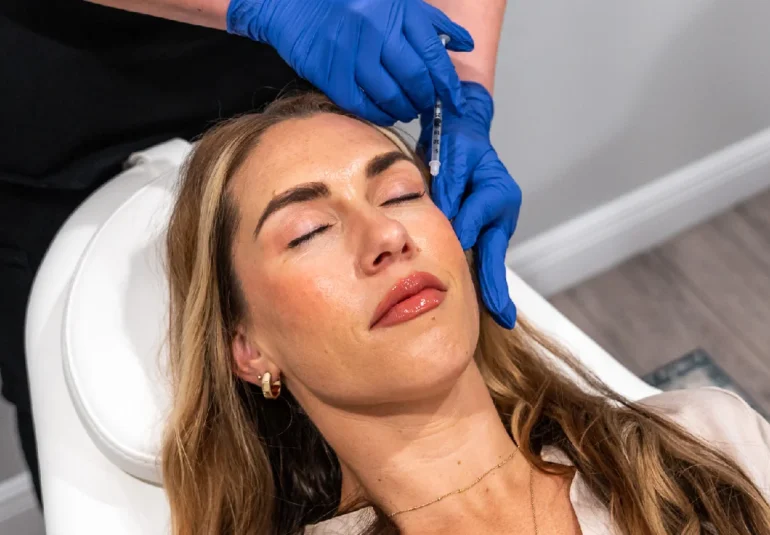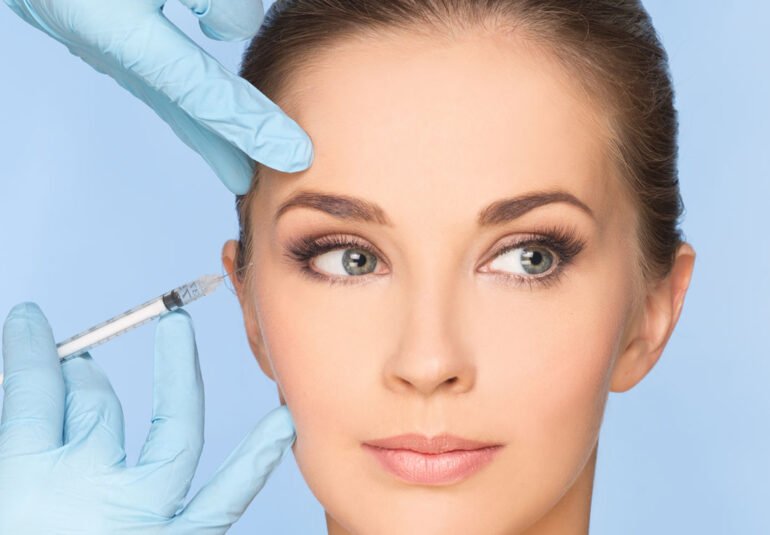
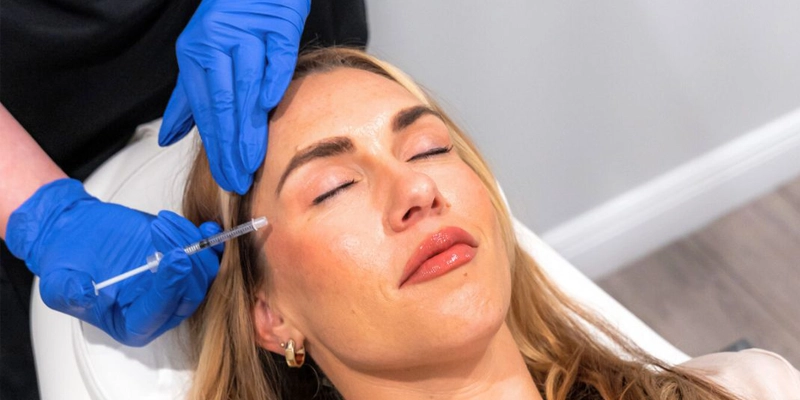
The medical spa industry has experienced a significant transformation, with neurotoxins emerging as a pivotal element in aesthetic and therapeutic treatments. This comprehensive guide delves into the role of neurotoxins, offering insights into their benefits, risks, and diverse applications.
Table of Contents
Understanding Neurotoxins
Neurotoxins are substances that have the ability to adversely affect the nervous system by disrupting or impairing nerve impulse transmission. In the context of medical spas, these substances are often utilized for cosmetic purposes, with a primary focus on anti-aging treatments.
One of the most commonly known neurotoxins used in medical spas is botulinum toxin, which is widely recognized under brand names such as Botox, Dysport, and Xeomin. These neurotoxins work by temporarily blocking the nerve signals in the muscles where they are injected. This, in turn, leads to muscle relaxation and a reduction in the appearance of fine lines and wrinkles, particularly those caused by repetitive muscle movements.
The mechanism of action involves the neurotoxin preventing the release of acetylcholine, a neurotransmitter responsible for signaling muscle contractions. By inhibiting this process, the muscles are temporarily paralyzed, resulting in a smoother and more youthful appearance of the skin.
Neurotoxin treatments are commonly sought after for areas such as the forehead, frown lines, and crow’s feet. The effects are generally temporary, requiring periodic treatments to maintain the desired results. While primarily associated with cosmetic applications, neurotoxins are also used for certain medical conditions, such as migraines and excessive sweating.
It’s important for individuals considering neurotoxin treatments to consult with qualified and experienced professionals in a medical spa setting. These professionals can assess individual needs, discuss potential side effects, and ensure that the treatment is administered safely and effectively. Additionally, clients should be informed about the temporary nature of the results and the need for repeat treatments to sustain the cosmetic benefits.
Neurotoxins used in medical spas, particularly for cosmetic purposes, include various formulations designed to reduce facial wrinkles and treat other conditions. Here are some types of neurotoxins commonly used in medical spa settings:
- Botulinum Toxin (Botox):
- Application: Botox is perhaps the most well-known and widely used neurotoxin in medical spas.
- Cosmetic Purpose: Primarily utilized for reducing facial wrinkles, Botox works by temporarily blocking nerve signals to the muscles, leading to muscle relaxation and a reduction in the appearance of fine lines and wrinkles.
- Areas of Use: Commonly applied to treat forehead lines, frown lines between the eyebrows (glabellar lines), and crow’s feet.
- Dysport:
- Similarity to Botox: Dysport is similar to Botox in that it is also a botulinum toxin type A formulation.
- Cosmetic Purpose: Like Botox, Dysport is used for cosmetic purposes to treat moderate to severe frown lines between the eyebrows.
- Quick Results: Some individuals may experience quicker results with Dysport compared to Botox, and the diffusion of Dysport is thought to spread more, potentially treating a larger area with fewer injections.
- Xeomin:
- Application: Xeomin is another botulinum toxin type A formulation.
- Cosmetic Purpose: Used for the treatment of frown lines and other facial wrinkles, Xeomin works by blocking nerve signals to the muscles, similar to Botox and Dysport.
- Naked Molecule: Xeomin is distinct in that it is a “naked” molecule, meaning it does not contain accessory proteins. This can be relevant for individuals who may be resistant to other neurotoxins due to the development of antibodies.
- Jeaveau (Newtox):
- Application: Jeaveau, often referred to as “Newtox,” is another botulinum toxin type A formulation.
- Cosmetic Purpose: Used for aesthetic purposes, Jeaveau is employed to reduce the appearance of facial wrinkles.
- Onset of Action: Some individuals may experience a relatively quick onset of action with Jeaveau, similar to Dysport.
- Revance:
- Application: Revance is a newer botulinum toxin type A formulation.
- Cosmetic Purpose: Used for treating facial wrinkles, Revance is known for its potential longer duration of action compared to other neurotoxins.
- Topical Formulation: There is ongoing research and development into a topical formulation of Revance, offering an alternative administration method.
It’s essential for individuals considering neurotoxin treatments to consult with qualified professionals in a medical spa setting. These professionals can assess individual needs, discuss specific product options, and ensure the safe and effective administration of the chosen neurotoxin for cosmetic purposes.
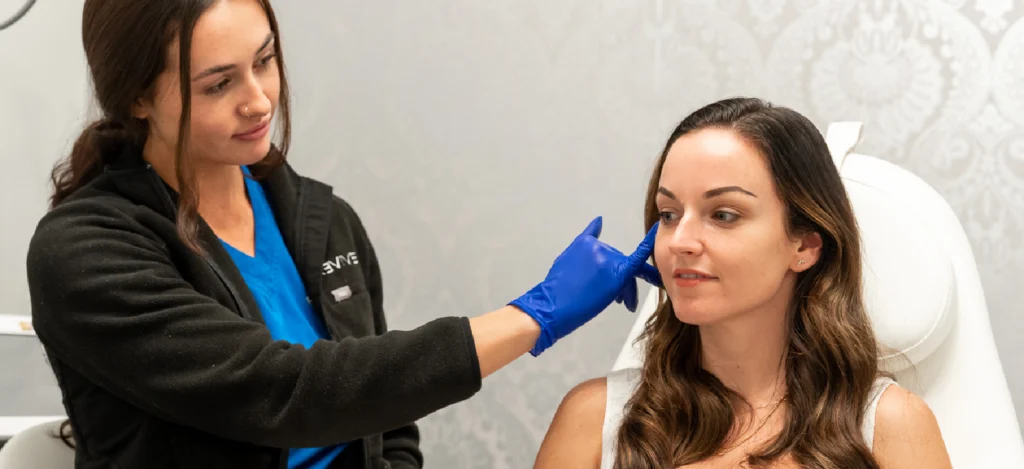
Applications of Neurotoxins in Medical Spas
Neurotoxins exhibit a versatile range of applications, making them valuable in various medical and cosmetic contexts:
- Wrinkle Reduction:
- Neurotoxins, such as Botox, Dysport, and Xeomin, are widely used for cosmetic purposes to reduce the appearance of wrinkles and fine lines.
- These substances work by temporarily paralyzing or relaxing facial muscles, particularly those responsible for dynamic wrinkles formed by repetitive muscle movements (e.g., smiling or frowning).
- By inhibiting muscle contractions, neurotoxins create a smoother and more youthful appearance of the skin, especially in areas like the forehead, frown lines, and crow’s feet.
- Hyperhidrosis Treatment:
- Neurotoxins are effective in treating hyperhidrosis, a medical condition characterized by excessive sweating.
- When injected into targeted areas such as the underarms, palms, or feet, neurotoxins block the nerve signals that stimulate sweat glands, reducing sweat production.
- This application provides relief for individuals experiencing significant discomfort and social impact due to uncontrollable sweating.
- Migraine Relief:
- Certain neurotoxins, specifically Botox, have received FDA approval for the treatment of chronic migraines.
- The injections are administered in specific areas around the head and neck to reduce the frequency and severity of migraine headaches.
- While the exact mechanism is not fully understood, it is believed that neurotoxins may interrupt pain pathways and inhibit the release of pain-related neurotransmitters.
- Muscle Spasm Control (Cervical Dystonia):
- Neurotoxins play a crucial role in managing conditions characterized by muscle spasms, such as cervical dystonia.
- Cervical dystonia is a neurological disorder causing involuntary muscle contractions in the neck, leading to abnormal head positions or movements.
- By blocking nerve signals to the affected muscles, neurotoxins can alleviate muscle spasms and provide relief for individuals with conditions involving involuntary muscle contractions.
It’s important to note that while neurotoxins offer these benefits, their administration should be carried out by trained and qualified professionals in a medical setting. Proper assessment, dosage, and administration are key factors in ensuring both safety and effectiveness across these diverse applications. Individuals considering neurotoxin treatments for any of these purposes should consult with healthcare professionals to determine the most suitable approach for their specific needs.
Table: Common Neurotoxin Treatments and Their Effects
| Treatment | Neurotoxin Used | Expected Outcome |
|---|---|---|
| Frown Lines | Botox, Dysport | Reduced appearance |
| Crow’s Feet | Botox, Xeomin | Smoother skin around eyes |
| Chronic Migraines | Botox | Decreased frequency |
| Excessive Sweating | Botox | Reduced sweat production |
Neurotoxins offer several benefits in the context of medical spas, making them a popular choice for individuals seeking non-surgical solutions for aesthetic enhancement. Here are some key advantages:
- Aesthetic Enhancement:
- Non-Surgical Solution: One of the primary benefits of neurotoxins in medical spas is their ability to provide aesthetic enhancement without the need for surgery.
- Reducing Signs of Aging: Neurotoxins, such as Botox, Dysport, and Xeomin, effectively reduce the appearance of fine lines and wrinkles, addressing common signs of aging on the face.
- Minimal Downtime:
- Quick Recovery: Neurotoxin treatments typically involve minimal downtime, allowing patients to resume their normal activities shortly after the procedure.
- Non-Invasive: As a non-invasive option, neurotoxin injections don’t require extensive recovery periods, making them suitable for individuals with busy schedules.
- Targeted Treatment:
- Precision in Application: Neurotoxin injections allow for precise and targeted treatment of specific areas on the face.
- Customizable: Medical spa professionals can tailor the treatment to address individual concerns, whether it’s forehead lines, frown lines, or crow’s feet.
- Quick Results:
- Rapid Onset of Action: One of the notable advantages of neurotoxin treatments is the quick onset of action.
- Visible Improvements: Patients often experience visible improvements within days of the treatment, with the full effects becoming more apparent in the following weeks.
- Convenience: The ability to achieve noticeable results relatively quickly makes neurotoxin treatments a convenient option for those seeking a rejuvenated appearance.
- Long-Lasting Results:
- Temporary Nature: While the effects of neurotoxin treatments are not permanent, they can last for several months.
- Repetition for Maintenance: Periodic follow-up treatments can help maintain the desired aesthetic results over time.
- Versatility in Applications:
- Beyond Cosmetic Use: Neurotoxins have applications beyond cosmetic purposes. They are also utilized for medical conditions such as hyperhidrosis (excessive sweating) and certain neurological disorders like migraines and muscle spasms.
- Low Risk of Side Effects:
- Generally Well-Tolerated: Neurotoxin treatments are generally well-tolerated with a low risk of side effects when administered by qualified professionals.
- Temporary Effects: Any potential side effects, such as bruising or mild swelling, are typically temporary and resolve on their own.
It’s crucial for individuals considering neurotoxin treatments to consult with experienced and qualified professionals in a medical spa setting. This ensures that the treatment is tailored to their specific needs, administered safely, and achieves the desired aesthetic enhancements.

Risks and Considerations
While neurotoxin treatments are generally considered safe when administered by qualified professionals, it’s important to be aware of potential risks and considerations associated with these procedures:
- Allergic Reactions:
- Rare Occurrence: Allergic reactions to neurotoxins are rare but possible.
- Symptoms: Allergic reactions may manifest as redness, itching, swelling, or hives at the injection site.
- Immediate Medical Attention: In the event of an allergic reaction, it is essential to seek immediate medical attention. Healthcare professionals can provide appropriate intervention and treatment.
- Temporary Side Effects:
- Swelling, Bruising, or Redness: It’s common to experience mild and temporary side effects at the injection site.
- Duration: Swelling, bruising, or redness typically resolve on their own within a few days to a week.
- Minimization Strategies: Skilled practitioners take precautions to minimize these side effects, such as using proper injection techniques and advising patients on aftercare practices.
- Overuse Risks:
- ‘Frozen’ Facial Appearance: Overuse or improper administration of neurotoxins can lead to a ‘frozen’ facial appearance.
- Loss of Natural Expression: Excessive use may result in a lack of facial mobility and expression, which can be undesirable for many individuals.
- Skilled Administration: To avoid this risk, it’s crucial for practitioners to have a thorough understanding of facial anatomy and use a conservative approach to maintain a natural and balanced appearance.
- Unintended Effects:
- Drooping or Asymmetry: In some cases, neurotoxin treatments may lead to unintended effects such as eyelid drooping or facial asymmetry.
- Temporary Nature: These effects are usually temporary, and corrective measures can be taken if necessary.
- Pregnancy and Breastfeeding:
- Limited Research: The safety of neurotoxin treatments during pregnancy and breastfeeding is not well-established due to limited research.
- Caution Advised: As a precautionary measure, many practitioners recommend avoiding these treatments during pregnancy and breastfeeding.
- Pre-existing Medical Conditions:
- Consultation Necessary: Individuals with certain pre-existing medical conditions may need to consult with their healthcare provider before undergoing neurotoxin treatments.
- Conditions Include: Conditions such as neuromuscular disorders may warrant special consideration and caution.
- Provider Qualifications:
- Choose a Qualified Professional: To mitigate risks, it’s essential to choose a qualified and experienced healthcare professional for neurotoxin treatments.
- Credentials: Look for practitioners with appropriate medical credentials and a history of successful neurotoxin administration.
- Long-Term Effects:
- Limited Research: Long-term effects of repeated neurotoxin treatments are not extensively studied.
- Periodic Assessments: Periodic assessments with healthcare professionals can help ensure the ongoing safety and appropriateness of treatments over time.
It’s crucial for individuals considering neurotoxin treatments to have thorough consultations with qualified professionals who can assess their individual health status, discuss potential risks, and provide personalized recommendations. Open communication with the practitioner and adherence to post-treatment instructions can contribute to a positive and safe experience with neurotoxin procedures.
Choosing the Right Medical Spa for Neurotoxin Treatments
- Certified Practitioners: Ensure the spa has licensed professionals.
- Customized Consultation: Look for personalized treatment plans.
- Quality of Products: Verify the authenticity of neurotoxins used.
- Client Reviews: Research other clients’ experiences.
In-Depth Look at Neurotoxin Procedures
Pre-Treatment Considerations
- Medical History Review: Essential to identify any potential risks.
- Skin Assessment: Determines the best treatment approach.
The Treatment Process
- Consultation: Discuss goals and expectations.
- Application: Precise injections in targeted areas.
- Post-Treatment Care: Guidelines to maximize results.
Post-Treatment Expectations
- Immediate Aftercare: Avoid touching or massaging the treated area.
- Follow-Up Appointments: Essential for assessing results and planning future treatments.
Advanced Neurotoxin Techniques
Medical spas are increasingly adopting advanced techniques for more nuanced results:
- Micro-Botox: Targets pores and fine lines for a more natural look.
- Combination Therapies: Using neurotoxins with fillers for enhanced results.
FAQs
1. How long do the effects of neurotoxin treatments last?
The effects typically last between 3 to 6 months, depending on individual response and the treated area.
2. Are neurotoxin treatments painful?
Most patients experience minimal discomfort, akin to a pinprick. Topical anesthetics can ease discomfort.
3. Can anyone get neurotoxin treatments?
Most adults can safely receive treatments, but they are not recommended for pregnant or breastfeeding women, individuals with certain neurological disorders, or those allergic to treatment components.
Future of Neurotoxins in Medical Spas
The future of neurotoxins in medical spas holds great promise, driven by continuous research and development efforts aimed at refining applications and techniques. As the understanding of these treatments evolves, there is a growing potential for safer, more effective, and more personalized neurotoxin applications. Here are some key aspects of the future of neurotoxins in medical spas:
- Emerging Trends and Research:
- New Formulations: Ongoing research is focused on developing new types of neurotoxins with unique properties. Scientists are exploring formulations that may have longer-lasting effects or fewer side effects compared to existing options like Botox, Dysport, and Xeomin.
- Tailored Solutions: The goal is to create neurotoxin formulations that can be tailored to individual needs, allowing for more precise and targeted treatments.
- Broader Applications:
- Medical Conditions Beyond Cosmetics: The future may see an expansion of neurotoxin applications beyond cosmetic purposes. Researchers are exploring the potential use of neurotoxins in treating various medical conditions, including depression and anxiety.
- Multidisciplinary Approaches: Collaborations between cosmetic and medical professionals could lead to innovative uses for neurotoxins in addressing broader health concerns.
- Technological Integration:
- Advanced Imaging Techniques: The integration of advanced imaging technologies may enhance the precision of neurotoxin treatments. Techniques such as 3D imaging or augmented reality could allow practitioners to visualize and plan injections with unprecedented accuracy.
- Precision Treatments: Technological advancements may enable more precise targeting of specific muscles or areas, reducing the risk of side effects and improving overall treatment outcomes.
- Personalized Approaches:
- Genetic and Personalized Medicine: The future may bring about advancements in understanding how an individual’s genetic makeup influences their response to neurotoxin treatments. This could lead to more personalized approaches, optimizing treatment plans based on genetic factors and other individual characteristics.
- Tailored Dosages: Precision medicine approaches may allow for the tailoring of neurotoxin dosages to each patient’s unique needs, optimizing both safety and efficacy.
- Education and Training:
- Increased Focus on Training: As the use of neurotoxins continues to expand, there may be an increased focus on education and training for healthcare professionals. This ensures that practitioners stay updated on the latest techniques, safety protocols, and emerging trends in neurotoxin applications.
- Patient Experience:
- Enhanced Patient Comfort: Future developments may prioritize enhancing the overall patient experience. This could include the development of more comfortable injection techniques, improved pain management strategies, and reduced recovery times.
- Global Accessibility:
- Wider Availability: With ongoing advancements, there is potential for neurotoxin treatments to become more widely available globally. This could contribute to increased accessibility and affordability for individuals seeking these procedures.
As research in the field of neurotoxins progresses, the future holds the promise of more sophisticated and diverse applications, ultimately benefiting both cosmetic and medical aspects of healthcare. Continued collaboration between researchers, healthcare professionals, and technology innovators will play a crucial role in shaping the landscape of neurotoxin treatments in medical spas.
Ethical and Regulatory Considerations
- Regulatory Compliance: Ensuring treatments meet health and safety standards.
- Ethical Marketing: Honest representation of treatment benefits and risks.
- Patient Education: Providing comprehensive information for informed decision-making.
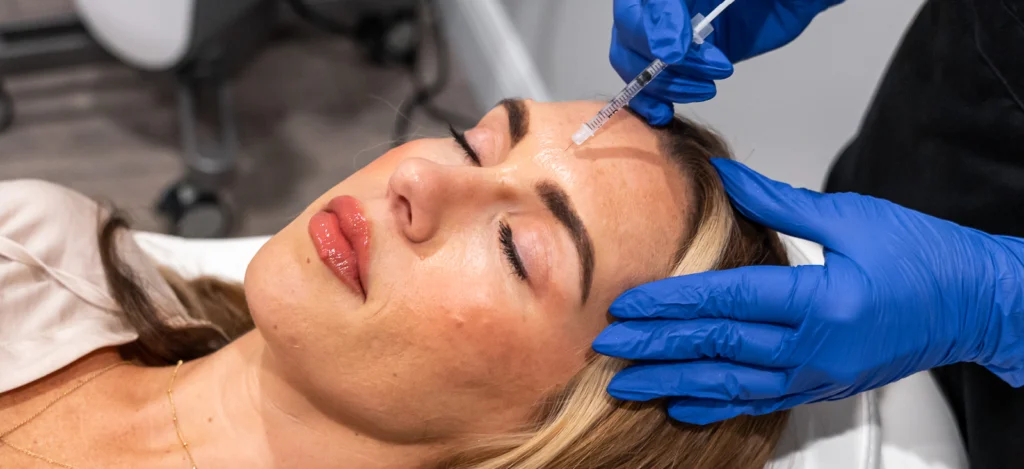
Neurotoxin Myths and Misconceptions
Dispelling common myths is crucial in understanding neurotoxin treatments:
- Myth: Neurotoxins are only for the elderly.
- Reality: They are used by a diverse age group for various reasons.
- Myth: Treatments result in an unnatural look.
- Reality: When administered correctly, they offer a natural appearance.
Conclusion
Neurotoxins have revolutionized the medical spa industry, offering a blend of aesthetic enhancement and therapeutic benefits. While they present a promising solution for various concerns, it’s crucial to approach these treatments with awareness and under professional guidance. By choosing the right medical spa and understanding the nuances of neurotoxin treatments, clients can safely enjoy the rejuvenating benefits they offer.
